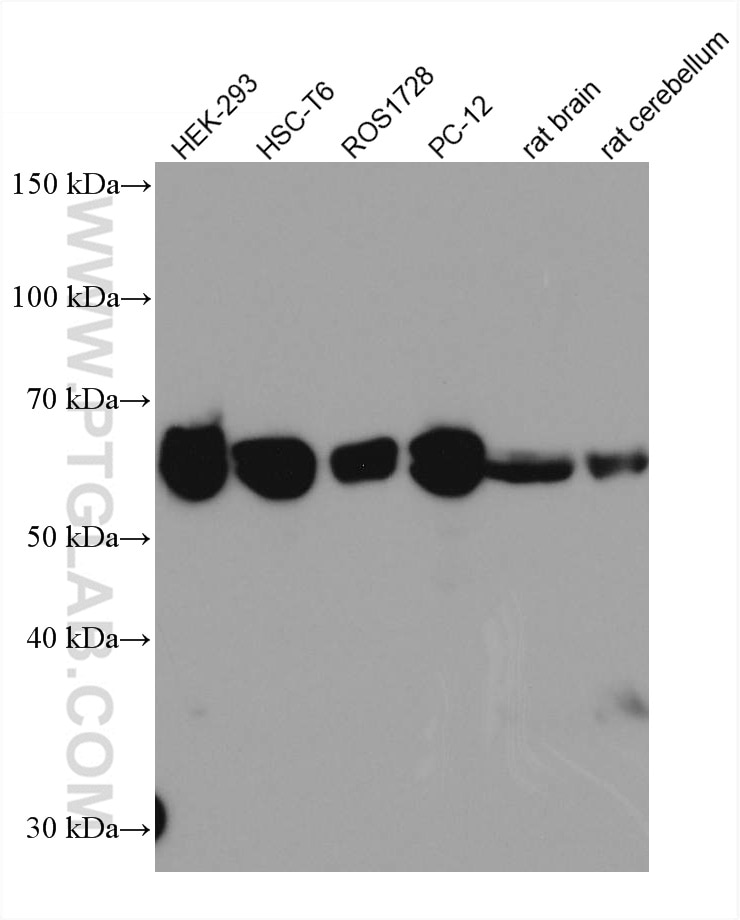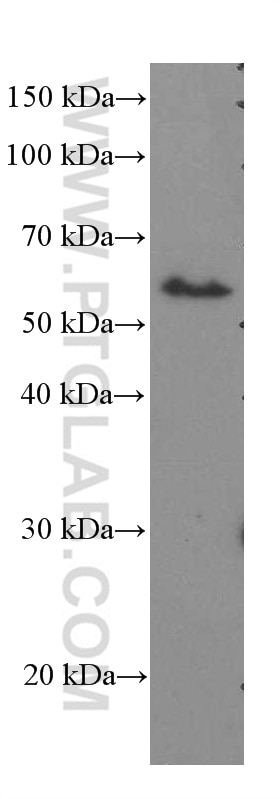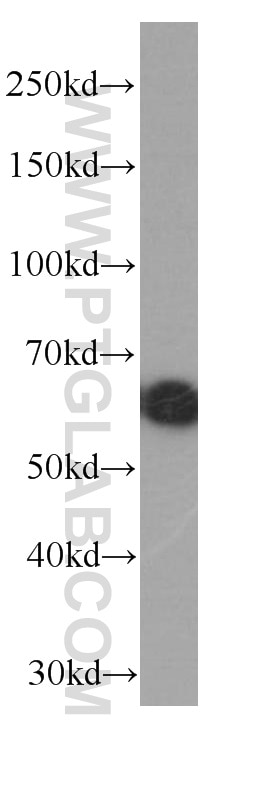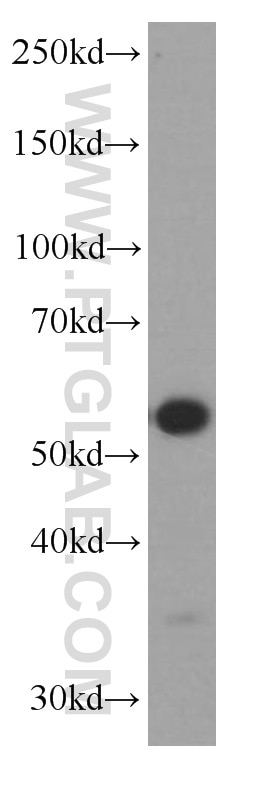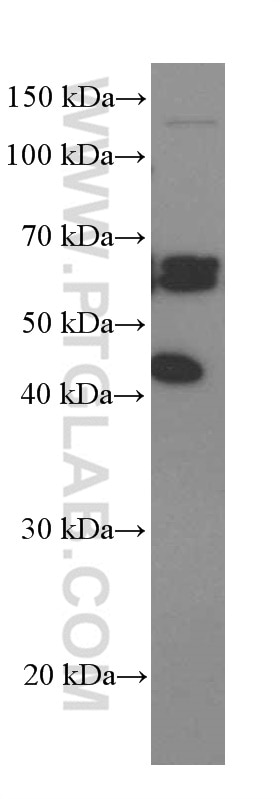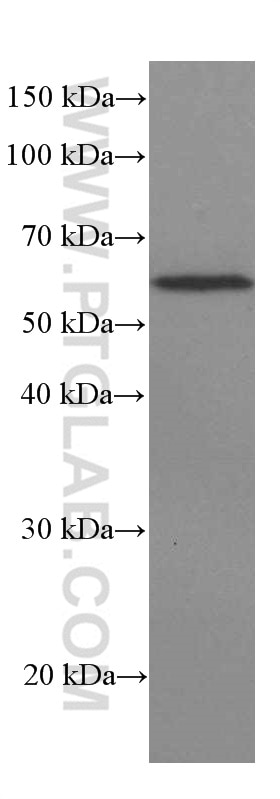IL-1RL1/ST2 Monoklonaler Antikörper
IL-1RL1/ST2 Monoklonal Antikörper für WB, ELISA
Wirt / Isotyp
Maus / IgG1
Getestete Reaktivität
Hausschwein, human, Maus, Ratte
Anwendung
WB, ELISA
Konjugation
Unkonjugiert
CloneNo.
7A2A7
Kat-Nr. : 60112-1-Ig
Synonyme
Geprüfte Anwendungen
| Erfolgreiche Detektion in WB | HEK-293-Zellen, fetales humanes Hirngewebe, Maushirngewebe, PC-12-Zellen, Hausschwein-Hirngewebe, Rattenhirngewebe, Ratten-Cerebellum-Gewebe, ROS1728-Zellen, SGC-7901-Zellen |
Empfohlene Verdünnung
| Anwendung | Verdünnung |
|---|---|
| Western Blot (WB) | WB : 1:5000-1:50000 |
| It is recommended that this reagent should be titrated in each testing system to obtain optimal results. | |
| Sample-dependent, check data in validation data gallery | |
Veröffentlichte Anwendungen
| KD/KO | See 1 publications below |
| WB | See 9 publications below |
Produktinformation
60112-1-Ig bindet in WB, ELISA IL-1RL1/ST2 und zeigt Reaktivität mit Hausschwein, human, Maus, Ratten
| Getestete Reaktivität | Hausschwein, human, Maus, Ratte |
| In Publikationen genannte Reaktivität | human, Hausschwein, Maus |
| Wirt / Isotyp | Maus / IgG1 |
| Klonalität | Monoklonal |
| Typ | Antikörper |
| Immunogen | IL-1RL1/ST2 fusion protein Ag2555 |
| Vollständiger Name | interleukin 1 receptor-like 1 |
| Berechnetes Molekulargewicht | 63 kDa, 37 kDa, 30 kDa |
| Beobachtetes Molekulargewicht | 63 kDa |
| GenBank-Zugangsnummer | BC030975 |
| Gene symbol | IL1RL1 |
| Gene ID (NCBI) | 9173 |
| Konjugation | Unkonjugiert |
| Form | Liquid |
| Reinigungsmethode | Protein-G-Reinigung |
| Lagerungspuffer | PBS with 0.02% sodium azide and 50% glycerol |
| Lagerungsbedingungen | Bei -20°C lagern. Nach dem Versand ein Jahr lang stabil Aliquotieren ist bei -20oC Lagerung nicht notwendig. 20ul Größen enthalten 0,1% BSA. |
Hintergrundinformationen
ST2, also known as IL1RL1, is a member of the IL-1 superfamily and serves as the receptor for IL-33. It plays a major role in immune and inflammatory responses. ST2 is expressed by various types of immune cells including Th2 cells, mast cells, type 2 innate lymphoid cells, eosinophils, basophils, NK cells, and non-immune cells, including cardiomyocytes. Two forms of ST2 exist: a membrane-bound form and a soluble form (sST2). The membrane-bound form activates the MyD88/NF-κB signaling pathway to enhance mast cell, Th2, regulatory T cell (Treg), and innate lymphoid cell type 2 functions. sST2 acts as a decoy receptor. (PMID: 27055914; 23999434; 28484466)
Protokolle
| PRODUKTSPEZIFISCHE PROTOKOLLE | |
|---|---|
| WB protocol for IL-1RL1/ST2 antibody 60112-1-Ig | Protokoll herunterladen |
| STANDARD-PROTOKOLLE | |
|---|---|
| Klicken Sie hier, um unsere Standardprotokolle anzuzeigen |
Publikationen
| Species | Application | Title |
|---|---|---|
Immunity Interleukin-33 Promotes Serotonin Release from Enterochromaffin Cells for Intestinal Homeostasis. | ||
Brain Behav Immun Fibroblast-derived IL-33 exacerbates orofacial neuropathic pain via the activation of TRPA1 in trigeminal ganglion neurons | ||
Neurology Association of Soluble ST2 With Functional Outcome, Perihematomal Edema, and Immune Response After Intraparenchymal Hemorrhage | ||
Sci Rep Dysfunctional EAT thickness may promote maladaptive heart remodeling in CVD patients through the ST2-IL33 system, directly related to EPAC protein expression. | ||
Sci Rep Fatty acid-binding protein 5 limits ILC2-mediated allergic lung inflammation in a murine asthma model. | ||
Cancer Biomark Targeting IL-17alpha to promote anti-PD-1 therapy effect by screening the tumor immune microenvironment in a mouse oral carcinogenesis model |
